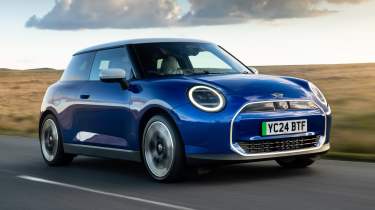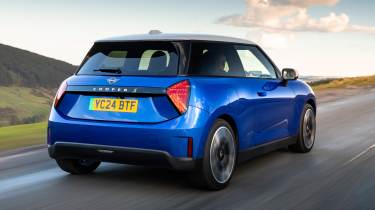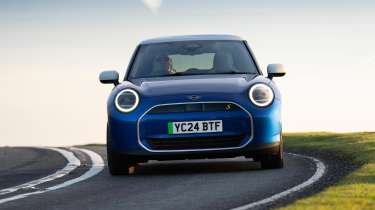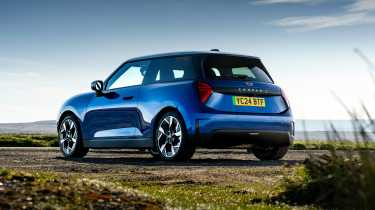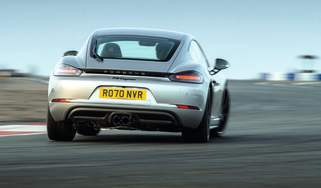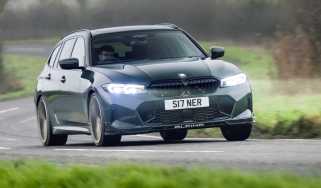Mini Cooper SE 2024 review – a new era of hot Minis
The Cooper SE is Mini’s first ground-up electric hot hatch – does Alpine’s A290 have a fight on its hands?
Mini is undergoing its biggest transformation since the turn of the millennium. Its future will be electric, and heavy investment is being pumped into new-gen models that will see the entire Mini range revamped by the end of this year. There's a buzz around the brand and it all sounds promising – until you read the spec sheet of the new Cooper SE hot hatch. 215bhp, 243lb ft, 250 miles of range, 1605kg… sorry, what? A three-door supermini that weighs as much as an Alfa Romeo Giulia Quadrifoglio? That must be a typo.
It isn't. Despite being built on a brand new EV platform the Cooper SE has piled on 240kg over its predecessor, surely giving it one of the worst size-to-weight ratios of any new car. The flip side is that some of that weight comes from a substantially larger 49.2kWh battery pack, which makes the new model (quite literally) miles more usable than the old one ever was with its puny 145-mile range. 95kW charging capability means a 10-80 per cent top-up takes half an hour.
> 2025 Mini John Cooper Works gets design tweaks but no more power
There's more power than before too. The SE still has a single electric motor mounted at the front, but its 215bhp output is 34bhp higher, with torque rated at 243lb ft compared to 199. Those numbers closely align with Alpine’s A290, which is shaping up to be a real contender in the electric hot hatch space going by our early drive in a prototype (evo 320). Being 126kg lighter the Alpine is the quicker of the pair, beating the Mini’s 6.7sec 0-62mph time by a few tenths.
More reviews
With that said, we’re glad that the SE isn’t a numbers freak. This isn’t an EV that commands your attention through its performance alone, which should bring other elements – the ones we most enjoy from a traditional hot hatch – into sharper focus. Weight aside, the fundamentals look good too, with the battery pack mounted within the floor for a low centre of gravity and the wheels pushed out to the extremes of the car, leaving slivers of overhang at the front and back.
Mini describes the new car's design language as ‘Charismatic Simplicity’. For everyone else, that means the body is stripped of chrome and unnecessary detailing to make it look neater and more modern, which it does. In base form the Mini is perhaps a bit too minimalist, missing some of the visual charm of its predecessors, but stepping up to the Cooper SE in Sport trim restores all the visual punch of previous hot Minis with JCW styling add-ons and aero paraphernalia. The only thing missing is a pair of central exhaust cannons.
From the inside, the outgoing Mini’s letterbox windscreen and mass of dashboard ahead made it feel bigger than it actually was, and while the new car has a familiar architecture, it feels a touch more airy, more welcoming and less enclosed. A large volume has been scooped out of the dash and there’s less clutter, with a simplified HMI system installed in the centre. This is both good and bad. Good in that the new, circular OLED screen is crisp, responsive and quick to react, but bad in that some functions force you to take your eyes off the road to delve deeper into the UI’s submenus. Quality is excellent for the most part though, and a cut above that of other superminis.
Twist the start/stop switch on the dash, click the gear selector down to drive and you set off in silence – or to the odd whooshing and warbling of the synthetic driving noise if you haven’t turned it off yet (we did after a few miles). Familiar Mini traits come through all the touch points straight away, and there’s a sharp, excitable energy to the driving experience. The SE is a hot hatch, and it wants you to know that through its quick steering, agitated ride and eager reactions. It’s been dialled up to deliver an immediate sense of fun, whereas something like an i20 N has more depth and does so through more authentic means.
The floor-mounted battery means you sit higher than you would in a petrol Cooper S, but there isn't much roll to amplify the effect of this. That's in part due to the low centre of gravity, but also because the chassis is tightly wound to control the mass. The springing is firm and the body bobs and jostles over imperfections, which can be tiring, but there's just enough cushioning through big impacts to take most of the harshness away.
The dampers are passive, but cycling through the drive modes amplifies other elements of the car's character. Go Kart mode sharpens the throttle and adds weight to the steering, but you can configure these parameters yourself (and switch between DSC settings) in the settings menu. The steering is best left in Comfort mode for lighter efforts and to amplify the car’s sense of agility, and with Sport for the powertrain and traction control disengaged, you need a degree of sensitivity in your right foot to drive cleanly out of corners. The Mini's planted cornering attitude can come undone very quickly if you demand all the torque at once, both front tyres lighting up as they might in a traditional front-drive hatch with a locking diff in the wet. It can feel scrappy, but managing power to the front axle gives you something to do, forcing you to adjust your lines and driving style to get the best from the SE.
Carry more speed, hustle the car through direction changes and it’s the rear that starts to break away, pivoting the nose in on a trailing throttle. You need to be aggressive to work through the SE’s inherent stability and you’re conscious of the high loads going through the tyres, but there’s progression in the transition to slip and it helps you set up for a smooth, straight release away from corners. Just make sure to leave some margin at the exit to account for a flicker of wheelspin and torque steer pulling you off line.
This window of adjustability is smaller and harder to access than in our favourite hot hatches, but it is there. And though the Cooper SE has the immediate pick-up and initial burst of acceleration we’re used to from EVs, you don’t arrive at corners with a frightening sense that a lot of speed needs to be scrubbed off very quickly. It’s one of the reasons why, unless you’re driving well outside of the car’s comfort zone, it doesn’t feel as heavy as it actually is.
That’s not to say Mini has completely nailed the formula for an electric hot hatch. In some ways, it feels like the SE is trying a little too hard to deliver an instant sense of fun, and while it does back this up to an extent, it’s still missing the authentic feel of the very best, an absorbing depth of character to learn, exploit and enjoy. But as a calling card for what the new era of electric hot hatches could offer, it’s a positive first step.
Price and rivals
The Cooper SE costs from £34,500, placing it in the mix with Abarth’s 500e, the MG4 XPower and the Cupra Born. The Abarth is the most affordable of the group at £31,195, but also the least powerful (150bhp) and lacks the Mini’s premium feel inside. The MG is the price-to-performance king, with £36,495 buying a dual-motor 429bhp powertrain and monster performance. However, that power isn’t matched to a cohesive, involving chassis, and the MG feels noticeably cheaper than the Cooper SE in every respect. Cupra offers its single-motor, 201bhp Born for £34,125, and while it isn’t as overtly sporting as the Mini, it delivers a different kind of enjoyment through its rear-drive chassis.
But the biggest test for the Cooper SE will come from France, in the form of the new Alpine A290. Being lighter than the Mini and developed with a heavy focus on engaging driving dynamics, the A290 has every chance of setting a new benchmark for electric hot hatches. If it’s priced anywhere near the Mini, expect a real dogfight between the two.

